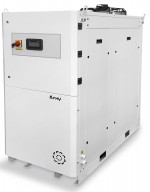Condition monitoring for process instrumentation
Published: 18 December, 2020
Plants such as water treatment facilities and food and beverage factories rely on a large range of process instrumentation – quite obviously, without accurate readings of parameters such as flow rates, pressures and temperatures, their operations would grind to a rapid halt. PWE reports.
Devices such as flow meters and pressure transmitters perform this vital work, but is enough attention paid to the health of these instruments – who monitors the monitor and how is it done in a way that improves the efficiency and performance of the whole plant?
Today’s process instrumentation is largely digitally based. As such they produce a wealth of information, not only about the behaviour of the parameters they are designed to measure, but also about their own performance and accuracy. Many modern devices can check their own circuitry, help with their own calibration and evaluate their own performance. Yet, these capabilities are not as widely used as they could be.
In the past, many plant operators took a reactive approach, where a device was allowed to break and then was fixed. This is an expensive which could lead to the whole plant tripping out, extended down time and a rush to find replacement parts or devices. In a batch production environment, such as mixing orange juice concentrate with liquid, the failure of a flow meter would not allow the right proportions to be mixed to produce the correct quality of product, stalling production. In a petrochemical process, based on 24/7 continuous production, allowing a temperature transmitter to simply fail could be potentially catastrophic.
In the 1970s to 80s, preventive maintenance came to the fore, with devices maintained to a schedule. This was highly manual, with equipment being checked by staff walking the line to note which devices were reading or behaving as expected and which ones needed attention.
Over the last few years, the concept of predictive maintenance has become ever more popular, with the aim of trying to prevent failure events. Although predictive maintenance is still a form of preventive maintenance, it uses actual condition-based data to determine when to perform maintenance, as opposed to a predetermined schedule based on historical information.
Condition monitoring of equipment allows us to schedule maintenance and prepare for it in advance, for example, ordering spare parts. We can also make use of the increasingly rich data available from measurement devices to identify exactly what went wrong and derive strategies or techniques to prevent the same problems occurring in the future.
There are two main reasons for condition monitoring. The first and most obvious is that we want to check the device’s health to ensure process and product quality, the second is ensuring that processes remain in a safe condition.
Using the data
So how can measurement device users begin to take advantage of these capabilities? At a very basic level, it comes down to how we communicate with the device. Although most measurement devices are digital, many applications continue to use the tried and tested 4-20mA current loop rather than digital communications networks.
For example, if 4-20mA measurement devices also offer HART communications, a bidirectional communication protocol that provides data access between intelligent field instruments and host systems. The communications link carries the process values, like flow rates or temperature. It also gives access to the device’s diagnostics data, such as its operational status. Many advanced digitally enabled measurement devices will offer sensor checks including internal connections, an indication of sensor memory failure and an internal electronics check.
With communications in place, device interrogation is the next step. There are twomethods for interrogating device data. The first is inbuilt condition monitoring and diagnostics based on the NAMUR NE 107 standard. To make things easier for technicians and other process personnel who need to deal with alarms, NAMUR NE 107 categorizes internal diagnostics into four standard status signals — failure, function check, out of specification and maintenance required, each of which can also contain greater detail. For example, with a failure signal, can the failure be traced to the device, or alternatively, is the process itself at fault?
Devices with NAMUR NE 107 diagnostics built in allow users to turn off diagnostics that are not required or configure how the diagnostics are reported. The standard alarm codes have been used to build an online diagnostic app known as My Measurement Assistant. The app allows users access to good quality and readily available self-service support features, which we have all come to expect with a quick internet search to find answers to questions.
In some cases dynamic QR codes are used to encrypt device maintenance and operating conditions and displaying on the instrument allowing less experienced personnel to streamline troubleshooting processes by scanning the QR code with their smartphone and being able to forward that information to an engineer working remotely for support.
Meanwhile, more proficient plant personnel can still get the details they desire to exercise their years of troubleshooting expertise. Maintaining accuracy One of the most important aspects of maintaining a device’s accuracy is field verification. Although much condition information is available through the HART connections, this does not provide enough detailed diagnostic information to determine if the device has drifted away from the parameters set at the factory or during commissioning.
Manual verification, performed by hand using multimeters and similar devices, has a number of drawbacks. As well as requiring longer downtimes, it also needs technicians to be specially trained. Software verification is faster.
The best modern verification software packages can be used for many device types, comparing their settings to when they were first commissioned or calibrated and determining if their performance has degraded since that time. With no need for any specially trained technicians, a report is produced on the calibration variables, assessing the limits and determining if the device has passed or failed on that parameter.
According to ABB, an organisation that upgraded to automated versus manual verification achieved an annual reduction in costs of over £750,000 (US$100,000). Operating 75 measurement devices, the organisation originally spent £112,000 (US$150,000) annually on verification for regulatory purposes, while annual maintenance and repair on the devices came to £750,000 (US$100,000). It also lost five percent of its production due to poor quality.
To aid these economic considerations, online tools are available allowing a user to enter the number of devices and calculate the cost of verifying them manually versus using verification software.
Selwood Pumps was able to reduce the verification testing time for its WaterMaster flowmeters from hours to just a few minutes using the ABB Ability PC based software tool. The pump hire company uses the tool to quickly and easily verify the accuracy of flowmeters used in its packaged pumping systems between hires, enabling it to ensure its customers can count on accurate measurement of pumped flows in their applications.
Making your move
Moving towards more use of condition monitoring depends on several factors. Not all a plant’s many devices are monitoring a critical process. It may be more economical to settle for reactive maintenance of these devices – they are usually very robust, with a life of some 10-20 years so there is an argument that running these less critical devices to failure is a viable philosophy. In the same plant, there may be other devices that really must be monitored for their health and accuracy, such as instrumentation, gas analysers or wastewater analysers used to comply with regulatory standards.
Cybersecurity is also a consideration. For automated monitoring, companies will need to feel confident that a chosen supplier has both the device and network expertise to keep data secure. Larger, more established vendors will have decades of experience in securing data from critical infrastructure such as power grids and refineries.
Ultimately, it is a cost versus benefit analysis. Yet, with very few purely analogue devices in existence and the increasingly rich data sets now available from digital instruments, using digital diagnostics to improve accuracy, cut maintenance costs, boost quality and productivity and ensure greater compliance to regulations makes increasing sense
https://twitter.com/ABBgroupnews https://www.linkedin.com/company/abb/






 The UltraChill range of process chillers go from 0.89 to 160 kW. These compact, energy efficient units are suitable for a wide range of process cooling applications and industry sectors, including automotive, engineering, food and drinks production, pharmaceutical, plastics, print and packaging, medical and scientific.
The UltraChill range of process chillers go from 0.89 to 160 kW. These compact, energy efficient units are suitable for a wide range of process cooling applications and industry sectors, including automotive, engineering, food and drinks production, pharmaceutical, plastics, print and packaging, medical and scientific. QUANTITECH reports it has launched a range of process gas analysers based on tuneable diode laser absorption spectroscopy (TDLAS). “Over 8,000 instruments have been installed around the world, but the manufacturer Focused Photonics Inc (FPi) is new to the UK,” says Quantitech MD Keith Golding.
QUANTITECH reports it has launched a range of process gas analysers based on tuneable diode laser absorption spectroscopy (TDLAS). “Over 8,000 instruments have been installed around the world, but the manufacturer Focused Photonics Inc (FPi) is new to the UK,” says Quantitech MD Keith Golding.
